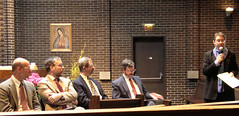Tom sent me an offline note that points to a blog that’s promulgating PDFs major works by postmodern theorists — in this case, Derrida’s Memoirs of the Blind. Tom points to this paragraph from fark yaralari:
For Derrida drawing is itself blind; as an act rooted in memory and anticipation, drawing necessarily replaces one kind of seeing (direct) with another (mediated). Ultimately, he explains, the very lines which compose any drawing are themselves never fully visible to the viewer since they exist only in a tenuous state of multiple identities: as marks on a page, as indicators of a contour. Lacking a “pure” identity, the lines of a drawing summon the supplement of the word, of verbal discourse, and, in doing so, obscure the visual experience. Consequently, Derrida demonstrates, the very act of depicting a blind person undertakes multiple enactments and statements of blindness and sight.
My first reaction is to note that I comment on Derrida only very hesitantly; in the past couple of years, I’ve arrived at richer understandings of Derridean writings about which I’d spoken publicly, and almost confidently, a number of times. Since I’ve only just glanced at Memoirs of the Blind, I haven’t had the time to afford a reflective assessment of the premise. Pending further illumination, though, I am inclined to see what Tom points out to me, a connection between Derrida’s thematic emphasis on the incompleteness of expressive gestures (on one hand) and my “brickliss hermeneutics” (on the other).
Tom goes on to wonder
One angle had to do with rhetoric and the arts of persuasion, and how what this seems to be is a sort of canned set of tropes, figures, devices to which expresser and receiver have, over long tradition, exposure to poetry and oratory etc., come to mutual ascribe certain meaningful effects.
This as then a repertoire, a middle ground of language resources, tones, syntactic patterns, etc., which “contains” ascribed elements of meaning. So, instead of two, three parts of the process of ascription.
So the triangulation expresser -> rhetorical device -> audience, while it would not actually “contain subsistent meaning,” would look as if it has, because of a variety of fixed expressive gestures.
Which is one way a two-chord guitar banger can emit something that offers far more than he could intend – these tropes are “in” us so deep, so basically, that the middle term, the congeries of language and theatre and gesture, speaks in ways that he couldn’t intend.
I think the “repertoire” angle is exactly correct, and I’m thankful to Tom for proposing it. I’ve discussed it before in conversations, but I think I’ve never incorporated the idea into my tediously copious writing on this theme. As Tom says, the repertoire stocks conventional discourse with familiar points of reference that seem so stable and so general that we’re tempted to think of the meaning as subsistent in the expression. Contrariwise, though, the stability and generality of the repertoire shows that you don’t need subsistent meaning where you have broadly-shared practices and conventions (to revert to a favorite example, our behavior with automobiles functions so very smoothly that traffic usually accommodates even the defiant or negligent drivers — but there’s no subsistent meaning in colored lights, stripes on roads, or even sides-of-the-road).
Tom goes on to ask “What about thinking?” Thought seems not to obey laws of conscious control, but to follow its own course of pondering, weighing, connecting, resisting, affirming; “But to the extent we are thinking through what we are thinking, bringing out its connections and complications and provisional conclusions, are we not in a relation that is less one of ascription than something else, which may have just as little to do with subsistent meaning, but isn’t so easily like the telos of a signifying practice?” I don’t have a canned answer to this query, but I suspect that it involves our capacity to imagine otherness (a capacity that experience shows us that people share to wildly varying degrees). For a thinker who has only a limited capacity to indwell a position she doesn’t actually hold (“negative capability,” right? though without leaping wholly onto the Romantic train) (OK, the failed metaphor of “leaping onto a train partway” has derailed me) — as I was saying, a thinker with limited insight into divergent perspectives will construe the world in terms of “sensible, correct” versus “wrong-headed, stubborn, obstructionist.” Such thinkers will tend to sense a stronger degree of subsistent meaning, since they’ll identify “what it means” strongly with “what I think.” A thinker who dwells more patiently with others’ perspectives will see less ground for supposing that any particular meaning subsists in expressions.
Well, that was a big digression. To return to Tom’s point, I would investigate the role of association in thinking — a big, elusive topic with its own controversies about causation and freedom, about repertoires and individuality, about (indeed) subsistent links among ideas and between ideas and realia.
This reminds me to make a connection to the vivid discussions among typographers concerning the status of fraktur (blackletter) typefaces in particular, though their reflections apply to typefaces in general. Through the fallout of a series of historical catastrophes, fraktur type has come to connote “Nazism” — even though the Nazis specifically discontinued the prevalent use of fraktur on which the German publishing and lettering conventions had relied for centuries before the rise of National Socialism. So, Nazi Germany declares fraktur type obsolete and adopts Roman typefaces — but the popular imagination links Nazi Germany with the typefaces that they rejected. Fraktur type signifies something, but that signification can’t be controlled by typographers (many of whom appreciate structural and historic characteristics of fraktur letterforms) or historians (who can explain that Nazi rejection of fraktur). So, is there “meaning” in an eszett?
But I have to get back to writing a short paper on the future of theological education.
